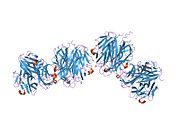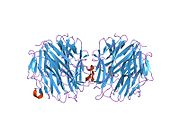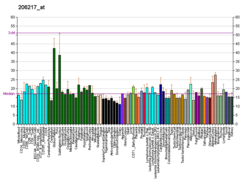Ectodysplasin A
| EDA | |||||||||||||||||||||||||||||||||||||||||||||||||||
|---|---|---|---|---|---|---|---|---|---|---|---|---|---|---|---|---|---|---|---|---|---|---|---|---|---|---|---|---|---|---|---|---|---|---|---|---|---|---|---|---|---|---|---|---|---|---|---|---|---|---|---|
 | |||||||||||||||||||||||||||||||||||||||||||||||||||
| |||||||||||||||||||||||||||||||||||||||||||||||||||
| Identifiers | |||||||||||||||||||||||||||||||||||||||||||||||||||
| Aliases | EDA, ECTD1, ED1, ED1-A1, ED1-A2, EDA-A1, EDA-A2, EDA1, EDA2, HED, HED1, ODT1, STHAGX1, XHED, XLHED, TNLG7C, ectodysplasin A | ||||||||||||||||||||||||||||||||||||||||||||||||||
| External IDs | OMIM: 300451; MGI: 1195272; GeneCards: EDA; OMA:EDA - orthologs | ||||||||||||||||||||||||||||||||||||||||||||||||||
| |||||||||||||||||||||||||||||||||||||||||||||||||||
| |||||||||||||||||||||||||||||||||||||||||||||||||||
| |||||||||||||||||||||||||||||||||||||||||||||||||||
| |||||||||||||||||||||||||||||||||||||||||||||||||||
| |||||||||||||||||||||||||||||||||||||||||||||||||||
| Wikidata | |||||||||||||||||||||||||||||||||||||||||||||||||||
| |||||||||||||||||||||||||||||||||||||||||||||||||||
Ectodysplasin A (EDA) is a protein that in humans is encoded by the EDA gene.
Ectodysplasin A is a transmembrane protein of the TNF family which plays an important role in the development of ectodermal tissues such as skin in humans.[5][6] It is recognized by the ectodysplasin A receptor.
Function
The protein encoded by this gene is a type II membrane protein that can be cleaved by furin to produce a secreted form. The encoded protein, which belongs to the tumor necrosis factor family, acts as a homotrimer and may be involved in cell-cell signaling during the development of ectodermal organs. Along with c-Met, it has been shown to be involved in the differentiation of anatomical placodes, precursors of scales, feathers and hair follicles in vertebrates.[7] Defects in this gene are a cause of ectodermal dysplasia, anhidrotic, which is also known as X-linked hypohidrotic ectodermal dysplasia. Several transcript variants encoding many different isoforms have been found for this gene.[6] At least 61 disease-causing mutations in this gene have been discovered.[8]
References
- ^ a b c GRCh38: Ensembl release 89: ENSG00000158813 – Ensembl, May 2017
- ^ a b c GRCm38: Ensembl release 89: ENSMUSG00000059327 – Ensembl, May 2017
- ^ "Human PubMed Reference:". National Center for Biotechnology Information, U.S. National Library of Medicine.
- ^ "Mouse PubMed Reference:". National Center for Biotechnology Information, U.S. National Library of Medicine.
- ^ Kere J, Srivastava AK, Montonen O, Zonana J, Thomas N, Ferguson B, Munoz F, Morgan D, Clarke A, Baybayan P, Chen EY, Ezer S, Saarialho-Kere U, de la Chapelle A, Schlessinger D (Sep 1996). "X-linked anhidrotic (hypohidrotic) ectodermal dysplasia is caused by mutation in a novel transmembrane protein". Nat Genet. 13 (4): 409–16. doi:10.1038/ng0895-409. PMID 8696334. S2CID 25690815.
- ^ a b "Entrez Gene: EDA ectodysplasin A".
- ^ Barrow-McGee R, Kishi N, Joffre C, Ménard L, Hervieu A, Bakhouche BA, et al. (2016). "Beta 1-integrin-c-Met cooperation reveals an inside-in survival signalling on autophagy-related endomembranes". Nature Communications. 7: 11942. Bibcode:2016NatCo...711942B. doi:10.1038/ncomms11942. PMC 4931016. PMID 27336951.
- ^ Šimčíková D, Heneberg P (December 2019). "Refinement of evolutionary medicine predictions based on clinical evidence for the manifestations of Mendelian diseases". Scientific Reports. 9 (1): 18577. Bibcode:2019NatSR...918577S. doi:10.1038/s41598-019-54976-4. PMC 6901466. PMID 31819097.
Further reading
- Cui CY, Schlessinger D (2007). "EDA signaling and skin appendage development". Cell Cycle. 5 (21): 2477–83. doi:10.4161/cc.5.21.3403. PMC 2860309. PMID 17102627.
- Srivastava AK, Montonen O, Saarialho-Kere U, Chen E, Baybayan P, Pispa J, Limon J, Schlessinger D, Kere J (1996). "Fine mapping of the EDA gene: a translocation breakpoint is associated with a CpG island that is transcribed". Am. J. Hum. Genet. 58 (1): 126–32. PMC 1914968. PMID 8554048.
- Montonen O, Ezer S, Saarialho-Kere UK, Herva R, Karjalainen-Lindsberg ML, Kaitila I, Schlessinger D, Srivastava AK, Thesleff I, Kere J (1998). "The gene defective in anhidrotic ectodermal dysplasia is expressed in the developing epithelium, neuroectoderm, thymus, and bone". J. Histochem. Cytochem. 46 (3): 281–9. doi:10.1177/002215549804600301. PMID 9487109.
- Ferguson BM, Thomas NS, Munoz F, Morgan D, Clarke A, Zonana J (1998). "Scarcity of mutations detected in families with X linked hypohidrotic ectodermal dysplasia: diagnostic implications". J. Med. Genet. 35 (2): 112–5. doi:10.1136/jmg.35.2.112. PMC 1051213. PMID 9507389.
- Hertz JM, Nørgaard Hansen K, Juncker I, Kjeldsen M, Gregersen N (1998). "A novel missense mutation (402C→T) in exon 1 in the EDA gene in a family with X-linked hypohidrotic ectodermal dysplasia". Clin. Genet. 53 (3): 205–9. doi:10.1111/j.1399-0004.1998.tb02678.x. PMID 9630076. S2CID 34921334.
- Monreal AW, Zonana J, Ferguson B (1998). "Identification of a new splice form of the EDA1 gene permits detection of nearly all X-linked hypohidrotic ectodermal dysplasia mutations". Am. J. Hum. Genet. 63 (2): 380–9. doi:10.1086/301984. PMC 1377324. PMID 9683615.
- Bayés M, Hartung AJ, Ezer S, Pispa J, Thesleff I, Srivastava AK, Kere J (1998). "The anhidrotic ectodermal dysplasia gene (EDA) undergoes alternative splicing and encodes ectodysplasin-A with deletion mutations in collagenous repeats". Hum. Mol. Genet. 7 (11): 1661–9. doi:10.1093/hmg/7.11.1661. PMID 9736768.
- Martínez F, Millán JM, Orellana C, Prieto F (1999). "X-linked anhidrotic (hypohidrotic) ectodermal dysplasia caused by a novel mutation in EDA1 gene: 406T > G (Leu55Arg)". J. Invest. Dermatol. 113 (2): 285–6. doi:10.1046/j.1523-1747.1999.00656.x. PMID 10469321.
- Ezer S, Bayés M, Elomaa O, Schlessinger D, Kere J (1999). "Ectodysplasin is a collagenous trimeric type II membrane protein with a tumor necrosis factor-like domain and co-localizes with cytoskeletal structures at lateral and apical surfaces of cells". Hum. Mol. Genet. 8 (11): 2079–86. doi:10.1093/hmg/8.11.2079. PMID 10484778.
- Yan M, Wang LC, Hymowitz SG, Schilbach S, Lee J, Goddard A, de Vos AM, Gao WQ, Dixit VM (2000). "Two-amino acid molecular switch in an epithelial morphogen that regulates binding to two distinct receptors". Science. 290 (5491): 523–7. Bibcode:2000Sci...290..523Y. doi:10.1126/science.290.5491.523. PMID 11039935.
- Drögemüller C, Distl O, Leeb T (2001). "Identification of a highly polymorphic microsatellite within the bovine ectodysplasin A (ED1) gene on BTA Xq22-24". Anim. Genet. 31 (6): 416. doi:10.1046/j.1365-2052.2000.00693.x. PMID 11167539.
- Elomaa O, Pulkkinen K, Hannelius U, Mikkola M, Saarialho-Kere U, Kere J (2001). "Ectodysplasin is released by proteolytic shedding and binds to the EDAR protein". Hum. Mol. Genet. 10 (9): 953–62. doi:10.1093/hmg/10.9.953. PMID 11309369.
- Vincent MC, Biancalana V, Ginisty D, Mandel JL, Calvas P (2001). "Mutational spectrum of the ED1 gene in X-linked hypohidrotic ectodermal dysplasia". Eur. J. Hum. Genet. 9 (5): 355–63. doi:10.1038/sj.ejhg.5200635. PMID 11378824.
- Chen Y, Molloy SS, Thomas L, Gambee J, Bächinger HP, Ferguson B, Zonana J, Thomas G, Morris NP (2001). "Mutations within a furin consensus sequence block proteolytic release of ectodysplasin-A and cause X-linked hypohidrotic ectodermal dysplasia". Proc. Natl. Acad. Sci. U.S.A. 98 (13): 7218–23. Bibcode:2001PNAS...98.7218C. doi:10.1073/pnas.131076098. PMC 34649. PMID 11416205.
- Sinha SK, Zachariah S, Quiñones HI, Shindo M, Chaudhary PM (2003). "Role of TRAF3 and -6 in the activation of the NF-kappa B and JNK pathways by X-linked ectodermal dysplasia receptor". J. Biol. Chem. 277 (47): 44953–61. doi:10.1074/jbc.M207923200. PMID 12270937.
- Kobielak A, Kobielak K, Biedziak B, Trzeciak WH (2003). "A novel mutation A1270G of the EDA1 gene causing Tyr343Cys substitution in ectodysplasin-A in a family with anhidrotic ectodermal dysplasia". Acta Biochim. Pol. 50 (1): 255–8. doi:10.18388/abp.2003_3734. PMID 12673367.
- Zhang XJ, Chen JJ, Song YX, Yang S, Xiong XY, Zhang AP, He PP, Gao M, Li YB, Lin D, Huang W (2004). "Mutation analysis of the ED1 gene in two Chinese Han families with X-linked hypohidrotic ectodermal dysplasia". Arch. Dermatol. Res. 295 (1): 38–42. doi:10.1007/s00403-003-0394-7. PMID 12682853. S2CID 26573351.
- Nishibu A, Hashiguchi T, Yotsumoto S, Takahashi M, Nakamura K, Kanzaki T, Kaneko F (2004). "A frameshift mutation of the ED1 gene in sibling cases with X-linked hypohidrotic ectodermal dysplasia". Dermatology. 207 (2): 178–81. doi:10.1159/000071790. PMID 12920369. S2CID 12792023.
External links
- GeneReview/NIH/UW entry on Hypohidrotic Ectodermal Dysplasia
- v
- t
- e
-
 1rj7: Crystal structure of EDA-A1
1rj7: Crystal structure of EDA-A1 -
 1rj8: The crystal structure of TNF family member EDA-A2
1rj8: The crystal structure of TNF family member EDA-A2
 | This article on a gene on the human X chromosome and/or its associated protein is a stub. You can help Wikipedia by expanding it. |
- v
- t
- e




















